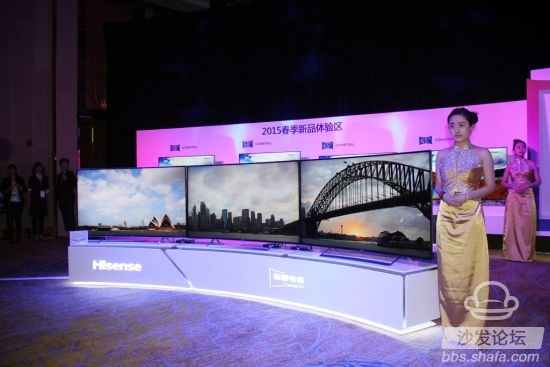Breaking the limits of Japan and South Korea’s monopoly “screen†and leading the formulation of international standards for LED backlighting; an innovation with more than 170 patents, which raised the display quality of LCD screens to world-class level and created “the first Chinese display technology†Reversal"...
For 33 years, relying on persistent industrial feelings and unceasing innovation spirit, Zhou Houjian, chairman of Hisense Group, and his team led by Hisense successfully met the challenges of the four core technologies in the development of China's color TV industry, not only for decades. Japanese and Korean companies have been using the "screen core group" core technology to suppress the development of China's color TV industry, but also sounded the horn of color TV technology "China era."

Direct hit "hidden pain": let China TV no longer "lose the core screen"
In 2001, Hisense suffered a loss but still invested heavily in R&D. Four years later, the first domestic audio and video processing chip with independent intellectual property rights and industrialization, “Xinxin†was born. The significance of "Sinxin" not only broke the history of China's annual output of 70 million color TV sets without Chinese cores. More importantly, the price of domestically-purchased foreign chips has been reduced by 50% after six months, and the overall benefit of China's color TV industry.
In 2005, the explosive growth of LCD TVs. Upstream companies such as South Korea and Japan have completely controlled the LCD panels, and even core components such as modules and signal processing have been integrated together, leaving China's color TV makers only a simple assembly and machining space such as housings and screws. In 2007, the Chinese market share of color TV brands in Japan and South Korea once occupied half of the country's market share.
In this regard, Zhou Houjian took the lead in the layout, resolutely to do their own LCD module, and gradually break through to the upstream of the industry chain. In 2007, the first domestic LCD module production line was put into production by Hisense. This breakthrough disrupts the plan of panel manufacturers to extend the monopoly of flat-panel TVs. After that, China’s color TV counterparts have set up their own module production lines, regaining space in the upper reaches of the whole machine, and an industrial crisis will be resolved. .
With the breakthrough of modular technology, Hisense quickly enriched the technology based on module backlight research. Two years later, in 2009, Hisense became the first person to lead the international standards for LED backlighting, making China have a higher autonomy in the LED panel era.
At the same time, the country has closely arranged the panel industry. With the successive launch of several high-end LCD panel production lines, including the BOE Chongqing 8.5-generation line, Huaxing Optoelectronics, and China National Electric Panda Nanjing, the Chinese panel's market share in the global market is expected to rise to 15%. Domestic panel self-sufficiency is expected to increase to more than 70%. With the support of the government, “the lack of cores and less screens†is a long-term “hidden pain†that restricts the healthy development of China's electronics manufacturing industry.
In the first quarter of 2015, Hisense TV ranked fourth in the world with 6.2% market share. Among the three indicators of 4K/2K, curved surface television and 50-59 large-size TV, Hisense TV has already ranked among the top three in the world. This is the first time in China's high-end market. The product enters the top three in the world.
Leading ahead: Cannot be led by foreign technology
However, for the first time in 13 consecutive years, the Chinese market did not allow Zhou Houjian the slightest ease. He saw more crises: LEDs will eventually be eliminated by new display technologies. Where does Hisense go?
Zhou Houjian believes that technology is not only a means of commercial competition for enterprises, but also a war of industrial security.
In 2011, Japanese and Korean companies launched OLED technology one after another, investing nearly 10 billion U.S. dollars a year, and they wanted to regain monopoly opportunities. This OLED, known as "Dream Monitor," will directly discard modules. Once OLED has been successfully promoted, the panel and backlight technology accumulated in China for many years will face the crisis of being eliminated or even abandoned. The core components of the screen will once again be controlled by foreign companies, and Chinese companies will once again fall into the “end of the industry chain subject to human†status.
Opportunities are always reserved for those who are prepared. In 2010, Zhou Houjian organized R&D personnel to make "dream display" based on LED-backlit LCD display. Zhou Houjian's consideration is far-reaching: OLED has low initial yield, poor reliability, and high cost. The pursuit of better quality is the true intention of consumption. If we meet or exceed the level of OLED in the picture quality, the cost is much lower than it, we can maintain the current situation and look for another opportunity.
This layout was finally broken after experiencing many hardships: In 2014, ULED was born. This innovation, which contains more than 170 technology patents, adopts backlight multi-zone dynamic control technology, peak brightness control technology, and backlight scanning control technology. The display quality effect of the LCD screen is upgraded to the world-class level, and it meets the same visual pursuing of the consumers for the future “Dream Monitor†at a lower cost.
This is an innovation and upgrading of the existing technology platform, but it has achieved unexpected results: The original, OLED screen brightness is limited, generally only 100nit, the peak brightness is generally only 400nit; and ULED after the general brightness can reach more than 400nit, The peak brightness can reach more than 900nit, plus ULED can achieve LED backlight and dual control of the LCD panel, to achieve a more precise control of light; OLED due to electroluminescence, its color gamut up to NTSC93%, and ULED combined quantum dot high The gamut reaches 100% NTSC. Therefore, ULED TVs can achieve higher contrast, color gamut, and black field effects. In terms of high dynamic range, ULED TVs are detected by Saixi Laboratories of China Electronics Technology Standardization Institute. Their dynamic contrast ratio is as high as 9 million:1, far exceeding the dynamic contrast ratio of 1,000 to 3,000 in common LED TVs.
ULED technology is gaining global attention today. At the CES show held in the United States this year, Samsung also launched a similar technical route to ULED's multi-zone independent backlight control, and this time, Hisense reserved it for five years in advance. In early August of this year, Hisense will also launch ULED in the United States in a high-profile manner, and at the same time export this technology to its global counterparts, which will drive the overall display level up. Zhou Houjian said that Hisense’s move was aimed at jointly blocking the speed of the OLED industry in the panel industry and leaving Chinese companies with time for growth.
The laser cinema is another "card" that Zhou Houjian played. He believes that in the past 40 years, Chinese companies have been led by foreign technology, and this nose is the "screen." In 2014, Hisense launched the world's first self-developed laser cinema, blew the horn in advance for the arrival of the “no screen†era, and even South Korean media exclaimed, “The laser display technology Hisense walked in front of South Koreans!â€
As a "fighter" to challenge one crisis after another, this is the dream and sentiment of Zhou Houjian and His Hisense industry leading the country. It is also a model for the development and value of China's color TV industry.
This content is copyrighted exclusively by SofaNet. Welcome manufacturers to further exchanges and cooperation with us to create more in-depth product reports.

Smart TV box recommended to install sofa butler, download address: http://app.shafa.com/
Sofa Net is an Internet technology company specializing in smart TVs and boxes. It owns popular products such as sofa butlers, sofa tables, and sofa forums. It has been committed to providing high quality application resources for smart TV and TV box users and active community exchanges. And authoritative evaluation of smart TV products.
LED Module Outdoor Full Color P6 Module Outdoor Led Display Module using the latest generation technology, 27777dots per square meter. P6 Module Outdoor Full Color with high refresh rate, anti corrosion, anti mildew, anti shock, anti electromagnetic. P6 Led Display Module is one good choice when compare Full Color Outdoor Led Display Module. We sincerely invite customers all over the world visit us for cooperation.
P6 Module Outdoor
P6 Module Outdoor,P6 Smd Led Module,P6 Outdoor Led Module,P6 Smd Outdoor Led Display Module
Shenzhen Jongsun Electronic Technology Co., Ltd. , https://www.jongsunled.com